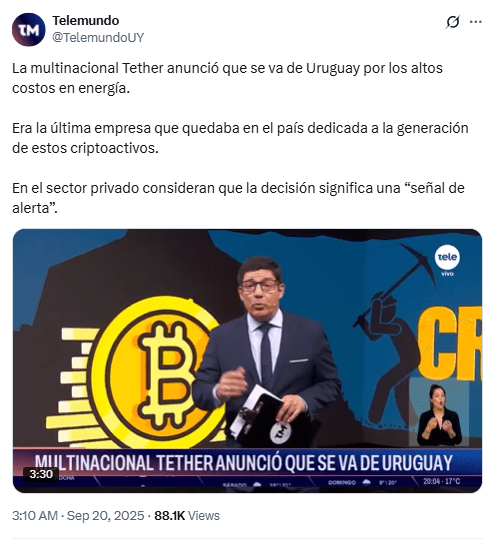Tether denied reports that it ditched its Uruguay project after a power dispute. The company said the exit claims “do not accurately reflect the situation.” It added that its local mining operator is in talks with the government.
Tether Uruguay plans started in November 2023 when the firm announced crypto mining in the country. Local media projected total investment for Tether mining in Uruguay could reach $500 million. Those plans referenced new sites and future growth.
UTE Electricity Debt: $2M May Bill and $2.8M More in Claims
Local outlet Telemundo reported that UTE cut power to the Tether Uruguay facilities. It cited a $2 million electricity bill for May that was unpaid. The same report said power was unplugged at the mining sites for non-payment.
Telemundo, citing Búsqueda, added that the local operator owed about $2.8 million for other projects.


The combined claims totaled roughly $4.8 million, excluding fines and surcharges. Búsqueda first reported the story two days earlier; Telemundo expanded it on Saturday.
Tether acknowledged the debt issue around its Uruguay mining venture. However, Tether Uruguay rejected talk of a full exit. The firm pointed to “ongoing discussions with the government to resolve the outstanding friction.” It said it supports its local operator’s efforts.
Uruguay vs Paraguay Power Costs: Key Factor for Tether Mining
Local coverage linked the alleged shutdown to high electricity costs in Uruguay. Tether Uruguay did not comment on pricing. Energy costs remain central to crypto mining economics in every region.
In Uruguay, electricity prices range from about $60 to $180 per megawatt hour (MWh). In Paraguay, electricity can be produced for around $22 per MWh from the Itaipú hydropower plant. The spread can reshape margins for Tether mining and other operators.
Tether also runs Bitcoin mining facilities in Paraguay. Local reports said Tether Uruguay negotiated with UTE for a new site and requested reduced electricity rates. Tether did not address those specific talks.

Vici Mining Example: Move from Uruguay to Paraguay in 2018
In 2018, Vici Mining moved its Bitcoin mining operations from Uruguay to Paraguay. The company cited lower electricity costs as the main reason. The decision shows how pricing can redirect crypto mining footprints.
Vici engineer Nicolás Ribeiro told Telemundo:
“If you look globally at the average electricity price, Uruguay is well above it.”
He added that electricity can account for 80% of operating costs in this industry. The weight of power pricing therefore shapes location choices.
Ribeiro said the Tether Uruguay dispute should act as a “warning signal” for policymakers. He emphasized the challenge of attracting and keeping energy-intensive industries. Local reports also noted talks between Tether and UTE about a potential new facility.
LATAM Stablecoin Adoption: USDT Payments and Savings Grow
While Tether Uruguay works through the dispute, stablecoin adoption in LATAM continues to expand. In Bolivia, Toyota, Yamaha, and BYD recently began accepting USDT for payments. The move followed strain on United States dollar reserves.
In Colombia, MoneyGram said its crypto app will let locals save in United States dollar stablecoins. The feature targets users seeking dollar exposure as the Colombian peso weakens. The rollout places USDT within everyday payments and savings flows.
These developments do not resolve the Tether Uruguay mining issue. However, they show USDT usage rising across Latin America. The broader context includes Tether mining in Paraguay and ongoing talks in Uruguay over the $4.8 million claim.
